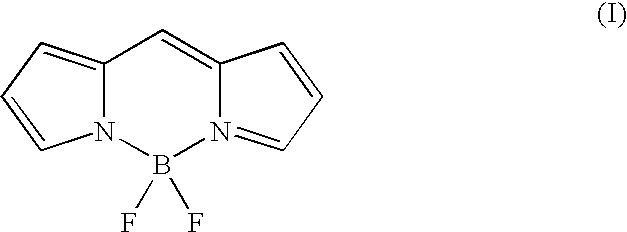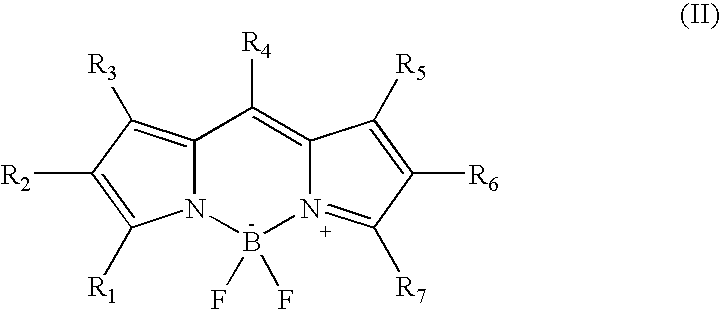Two-photon absorbing dipyrromethenboron difluoride dyes and their applications
a dipyrromethenboron and difluoride technology, applied in the direction of group 3/13 element organic compounds, material analysis through optical means, carrier-bound/immobilised peptides, etc., can solve the problem of limiting the use of biomolecule fluorescent labelling, low signal level, and phenomenon remained for a long time without practical use, etc. problem, to achieve the effect of maximising the two-photon fluorescence signal, reducing the singlet-triplet crossing rate, and reducing the singlet-tripl
- Summary
- Abstract
- Description
- Claims
- Application Information
AI Technical Summary
Benefits of technology
Problems solved by technology
Method used
Image
Examples
example 2
[0066] 4,4-difluoro-1,3,5,7-tetramethyl-4-bora-3a,4a diaza-sindacene-2,6-dipropionic Acid (2)
[0067] Dipyrrylmethene hydrobromide (compound 1) (500 mg, 1.17 mmol) was suspended in chloroform (20 ml) and triethylamine (4.3 ml, 31 mmol) was added. The starting dipyrrylmethene dissolved immediately after triethylamine addition (4.3 ml, 31 mmol). Boron trifluoride ethyletherate (5 ml, 31 mmol) was added. Reaction mixture was stirred at room temperature for 2.5 h. The reaction mixture was diluted with chloroform (50 ml), washed with dilute HCl (5%, 30 ml) and water (30 ml). Small amount (5%) ethanol was added in order to perform efficient extraction. Chloroform phase was evaporated to dryness in rotary evaporator and the product (compound 2) was precipitated from ethanol / water (7 days at +4.degree. C.) yielding brown-orange powder. The yield after drying the product, compound 2, in vacuum desiccator was 420 mg (92%).
[0068] .sup.1HNMR (JEOL JNM-LA400, DMSO-d.sub.6, 400 MHz, .delta. ppm): 2...
example 3
[0069] 4,4-difluoro-1,3,5,7-tetramethyl-6-carboxyethyl-4-bora-3a,4a-diaza--s-indacene-2-propionic acid succinimidylester (3)
[0070] 4,4'-difluoro-1,3,5,7-tetramethyl-4-bora-3a,4a-diaza-s-indacene-2,6--dipropionic acid (compound 2) (102 mg, 0.26 mmol) was dissolved in N,N-dimethylformamide (2.5 ml, dry). N-hydroxysuccinimide (90 mg, 0.78 mmol) and N,N'-dicyclohexyl-carbodiimide (54 mg, 0.26 mmol) were added. Reaction mixture was stirred for 24 h at room temperature. N,N-dimethylformamide was evaporated (5 mbar, 40-50.degree. C.) and the product was purified with column chromatography using silica as a stationary phase and dichloromethane:acetone:acetic acid (100:8:1, v:v:v) as an eluent. Fractions containing the desired mono-succinimidyl ester (compound 3) were combined and evaporated to dryness. The residue was dissolved into small amount of dichloromethane. Petroleum ether (bp 40-60.degree. C.) was added to precipitate the product. The solution was filtrated and the precipitated pro...
example 4
[0073] 4,4-difluoro-5-(2-thienyl)-1,3-dimethyl-4-bora-3a,4a-diaza-s-indace-ne-2-propionic Acid Methyl Ester (4).
[0074] 2-formyl-5-(2-thienyl)pyrrole (150 mg, 0.84 mmol) and 2,4-dimethyl-3-carboxy-ethylpyrrole (140 mg, 0.84 mmol) were dissolved in dichloromethane:methanol (10:1, 30 ml). Phosphorus oxychloride (77 .mu.l, 0.84 mmol) was added and solution was stirred at room temperature for 18 h. Reaction mixture were evaporated to dryness and the residue was dissolved in dichloromethane (150 ml). N-ethyl-N,N-diisopropylamine (1.44 ml, 8.4 mmol) and boron trifluoride ethyl etherate (1.06 ml, 8.4 mmol) were added. Strong orange fluorescence was observed immediately after the addition of boron trifluoride ethyl etherate. The reaction mixture was washed with water, dried with sodium sulphate and evaporated to dryness. The crude product was purified with column chromatography using silica as a stationary phase and dichloromethane as an eluent. Fractions containing the desired product were ...
PUM
| Property | Measurement | Unit |
|---|---|---|
| diameter | aaaaa | aaaaa |
| concentration | aaaaa | aaaaa |
| concentration | aaaaa | aaaaa |
Abstract
Description
Claims
Application Information
 Login to View More
Login to View More - R&D
- Intellectual Property
- Life Sciences
- Materials
- Tech Scout
- Unparalleled Data Quality
- Higher Quality Content
- 60% Fewer Hallucinations
Browse by: Latest US Patents, China's latest patents, Technical Efficacy Thesaurus, Application Domain, Technology Topic, Popular Technical Reports.
© 2025 PatSnap. All rights reserved.Legal|Privacy policy|Modern Slavery Act Transparency Statement|Sitemap|About US| Contact US: help@patsnap.com



